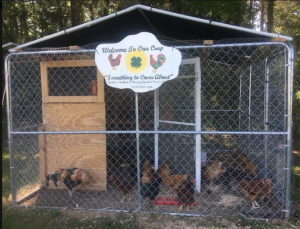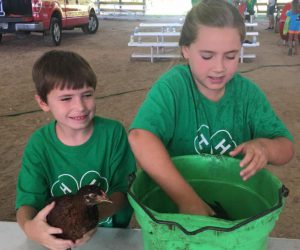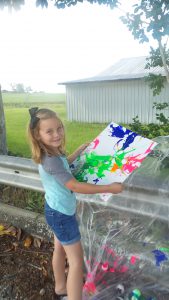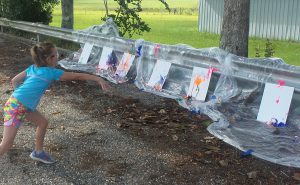The Scoop on Backyard Coops

Many Extension Offices offer Cooperative Coops for youth who live in areas that are not zoned for poultry – UF/IFAS Jackson County Extension 4-H Program
Photo Credit: Angel
If you have been entertaining the idea of adding chickens to your personal “flock”, then we have some news for you! Not only would you be adding a sustainable practice at your home, your youth would have amazing opportunities to learn, develop valuable life skills and explore opportunities in 4-H. Youth from all walks of life (urban and rural) are involved in 4-H poultry projects. Here’s the scoop on getting started with backyard coops:
- Location– the first thing you need to find out is whether or not your location is zoned for poultry and whether or not there are any building restrictions. If there are no restrictions on your property, you will want to select a location that is relatively flat, has good drainage, access to electricity and water, and some natural shade if possible. If you do live in a restricted area, contact your local UF IFAS County Extension Office– many offices have cooperative coops where youth can participate in the poultry project, even if they can’t have their own backyard coop.
- Goal– Next, you need to consider what your goal is. Do you plan to produce just eggs or are you considering producing your own meat? Are you more interested in showing your chickens? How big of an operation are you planning?
- Coop Size– Are you planning to allow your birds to free-range or stay in an enclosed pen? Birds that are allowed to roam free during the day do not need as large a coop. If you are planning to keep your birds cooped up to keep them safe from neighborhood dogs or wildlife, you will need a larger coop. Also, the number of birds and breeds you want to have will impact your coop size. Here are the general rules of thumb when it comes to coop size:
- Heavy breeds– such as Australorp, Barred Rock, or Buff Orphington need 4 square feet of space if allowed out to forage during the day, but 10 square feet of space per bird if they are kept in the coop.
- Light breeds– such as Leghorn, Araucana or Silkies need 3 square feet of space per bird if allowed to forage, but 71/2 square feet of space per bird if kept in the coop.
For more information on selecting breeds, check out this article: Which Breeds are Best for Backyard Poultry.
- Coop Style– Chickens have been around for thousands of years so they are pretty resilient, but you still need to consider giving them proper shelter and protection from the elements and predators. Make sure that your coop has the capability to repel predators that fly, dig or crawl. Chickens are susceptible to birds of prey such as hawks and owls as well as predators on the ground including snakes, opossums, raccoons, coyotes, dogs and cats. There are many styles to choose from and you can spend a lot or a little, depending on your budget or your skills as a carpenter! Links to a few example coop plans are provided in the resources below. Many hardware and feed supply stores have “coop kits” for sale that are easy to put together. Generally, these coops are for small numbers of birds and are easy to remove should you change your mind about having a backyard flock later. The coop shown above was constructed with a 10 x 10 chain-link dog kennel and a canvas kennel cover. The roof and sides were laced with poultry wire which was also buried 8-10 inches in the ground around the perimeter. An enclosed area with laying boxes was constructed out of scrap lumber, an old screen door and a roll of window screen. All of the components give the birds protection from the elements and predators. Make sure that your coop site has access to electricity and water.
If you have decided to incorporate some of the 4-H activities such as embryology or Chick Chain, you will be starting with day-old chicks that will require a little different living environment, at least until they can keep themselves warm and are big enough to be put on the ground. Regardless of the age of the birds, make sure that you are providing adequate amounts of fresh feed and clean water every day.
Once your birds are mature enough to lay eggs or be used for meat, you will enjoy having a great source of protein and a valuable teaching tool for youth. Learning skills such as record keeping and responsibility are just two of the skills that come to mind. Not to mention opportunities in learning to show or exhibit birds, learning about poultry and meats judging, earning scholarships in the 4-H Tailgate Cookery Contest and developing entrepreneurial skills in producing eggs or meat for your family or others.
There are multiple opportunities in 4-H poultry project. If you are interested in participating, either as a youth member or an adult volunteer, contact your local UF IFAS County Extension Office or visit http://florida4h.org.
Resources:
Florida 4-H Chick Chain Project
Florida 4-H Poultry Project Page
Florida 4-H Embryology Program
Life Skill Development Related to Participation in 4-H Animal Science Projects




